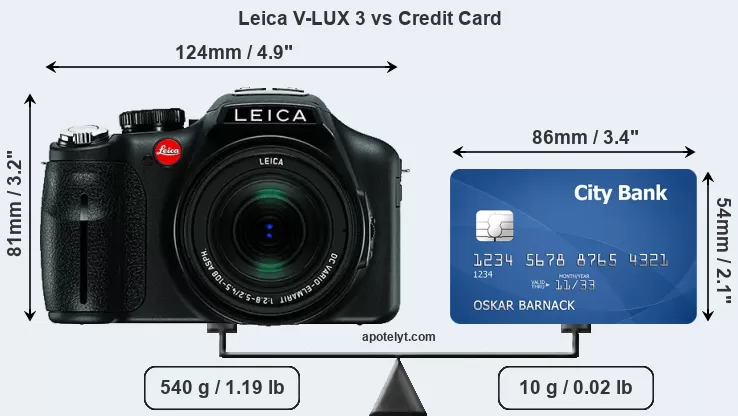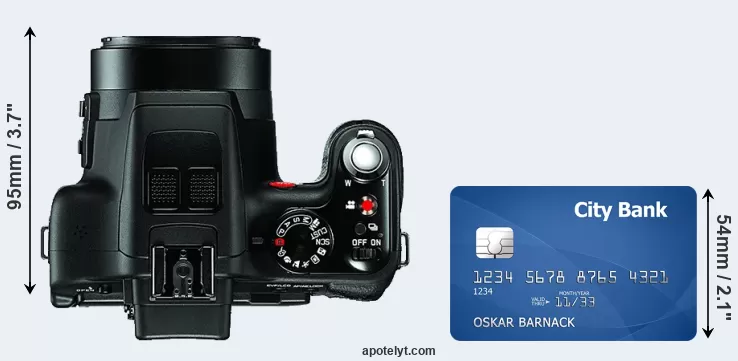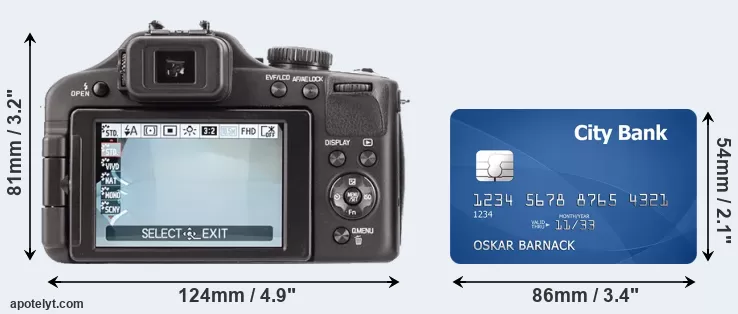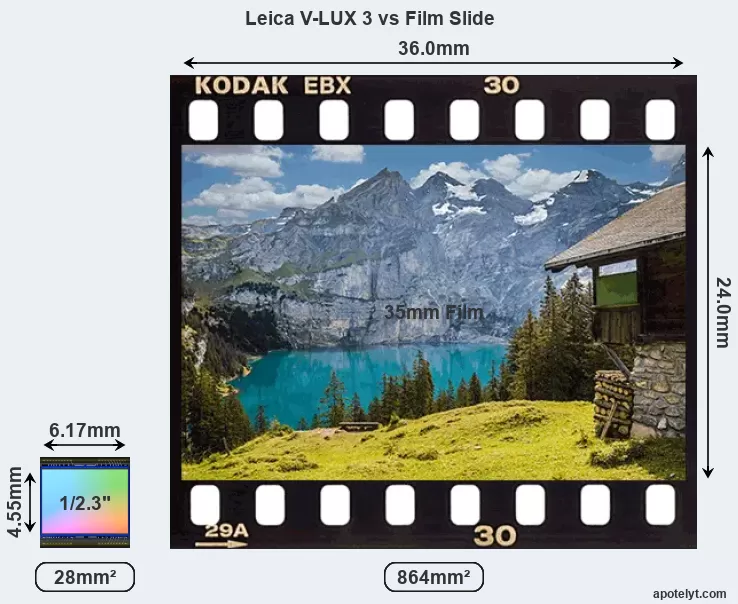Leica V-LUX 3 Comparison Review
The Leica V-LUX 3 is a fixed lens compact camera that was revealed to the public in December 2011 and is equipped with a 1/2.3-inch sensor. It offers a resolution of 12 megapixel.

Is the Leica V-LUX 3 a good camera? The V-LUX 3 has a Camera Elo of 1492. This rating puts the V-LUX 3 below average of all superzoom compact cameras. In terms of its sensor size category (small sensor cameras), the V-LUX 3 also ranks below average. Based on its within category standings, the camera earns a 2.5-star performance rating. – Well, the Leica V-LUX 3 is more than 12 years old, and there have been many other good digital cameras released since 2011.
| Leica V-LUX 3 |
|---|
| Fixed lens compact camera |
| 25-600mm f/2.8-5.2 |
| 12 MP, 1/2.3" Sensor |
| 1080/60p Video |
| ISO 100 - 3 200 (100 - 6 400) |
| Electronic viewfinder (202k dots) |
| 3.0 LCD, 460k dots |
| Swivel screen (not touch-sensitive) |
| 12 shutter flaps per second |
| 410 shots per battery charge |
| 124 x 81 x 95 mm, 540 g |
Read on to find out more about the camera's size, sensor, features, reception by expert reviewers, and how it compares to other digital cameras.
Body comparison with a credit card
The physical dimensions of the Leica V-LUX 3 relative to a credit card are illustrated in the side-by-side display below. Three successive views from the front, the top, and the rear are shown. All width, height and depth measures are rounded to the nearest millimeter.



The table below summarizes the key physical specs of the Leica V-LUX 3 alongside a set of similar cameras. If you want to review a particular camera pair side-by-side, just move across to the CAM-parator tool and choose from the broad selection of possible comparisons there.

| Camera Model |
Camera Width |
Camera Height |
Camera Depth |
Camera Weight |
Battery Life |
Weather Sealing |
Camera Launch |
Launch Price (USD) |
Street Price |
||
|---|---|---|---|---|---|---|---|---|---|---|---|
| 1. | Leica V-LUX 3 | 124 mm | 81 mm | 95 mm | 540 g | 410 | n | Dec 2011 | 949 | ebay.com | |
| 2. | Canon G1 X | 117 mm | 81 mm | 65 mm | 534 g | 250 | n | Jan 2012 | 799 | ebay.com | |
| 3. | Canon G1 X Mark II | 116 mm | 74 mm | 66 mm | 553 g | 240 | n | Feb 2014 | 799 | ebay.com | |
| 4. | Canon SX30 | 123 mm | 92 mm | 108 mm | 601 g | 370 | n | Sep 2010 | 429 | ebay.com | |
| 5. | Canon SX40 | 123 mm | 92 mm | 108 mm | 600 g | 380 | n | Sep 2011 | 429 | ebay.com | |
| 6. | Canon SX50 | 123 mm | 87 mm | 106 mm | 595 g | 315 | n | Sep 2012 | 429 | ebay.com | |
| 7. | Leica V-LUX 2 | 124 mm | 80 mm | 95 mm | 520 g | 410 | n | Sep 2010 | 849 | ebay.com | |
| 8. | Leica V-LUX 4 | 125 mm | 87 mm | 110 mm | 588 g | 540 | n | Sep 2012 | 949 | ebay.com | |
| 9. | Panasonic FZ100 | 124 mm | 82 mm | 92 mm | 540 g | 410 | n | Jul 2010 | 499 | ebay.com | |
| 10. | Panasonic FZ150 | 124 mm | 82 mm | 92 mm | 528 g | 410 | n | Aug 2011 | 499 | ebay.com | |
| 11. | Panasonic FZ200 | 125 mm | 87 mm | 110 mm | 588 g | 540 | n | Jul 2012 | 599 | ebay.com | |
| Note: Measurements and pricing do not include easily detachable parts, such as add-on or interchangeable lenses or optional viewfinders. | |||||||||||
The listed prices provide an indication of the market segment that the manufacturer of the cameras have been targeting. The Leica V-LUX 3 was launched in the US market at a price of $949. Usually, retail prices stay at first close to the launch price, but after several months, discounts become available. Later in the product cycle and, in particular, when the replacement model is about to appear, further discounting and stock clearance sales often push the camera price considerably down. Then, after the new model is out, very good deals can frequently be found on the pre-owned market.

Check V-LUX 3 offers at
ebay.com
Sensor comparison with a 35mm slide
The imaging sensor is at the core of digital cameras and its size is one of the main determining factors of image quality. A large sensor will tend to have larger individual pixels that provide better low-light sensitivity, wider dynamic range, and richer color-depth than smaller pixel-units in a sensor of the same technological generation. Further, a large sensor camera will give the photographer additional creative options when using shallow depth-of-field to isolate a subject from its background. On the downside, larger sensors are more costly to manufacture and tent to lead to bigger and heavier cameras and lenses.
The Leica V-LUX 3 features a 1/2.3-inch sensor and has a format factor (sometimes also referred to as "crop factor") of 5.6. Within the spectrum of camera sensors, this places the Leica V-LUX 3 among the smaller-sensor digicams that favor affordability and compact design.

Consistent information on actual sensor performance is available from DXO Mark for most cameras. This service is based on lab testing and assigns an overall score to each camera sensor, as well as ratings for dynamic range ("DXO Landscape"), color depth ("DXO Portrait"), and low-light sensitivity ("DXO Sports"). The following table provides an overview of the physical sensor characteristics, as well as the sensor quality measurements for a selection of alternatives.

| Camera Model |
Sensor Class |
Resolution (MP) |
Horiz. Pixels |
Vert. Pixels |
Video Format |
DXO Portrait |
DXO Landscape |
DXO Sports |
DXO Overall |
||
|---|---|---|---|---|---|---|---|---|---|---|---|
| 1. | Leica V-LUX 3 | 1/2.3 | 12.0 | 4000 | 3000 | 1080/60p | 19.7 | 11.0 | 430 | 42 | |
| 2. | Canon G1 X | 1.5-inch | 14.2 | 4352 | 3264 | 1080/24p | 21.7 | 10.8 | 644 | 60 | |
| 3. | Canon G1 X Mark II | 1.5-inch | 13.0 | 4160 | 3120 | 1080/30p | 21.5 | 10.8 | 581 | 58 | |
| 4. | Canon SX30 | 1/2.3 | 14.0 | 4320 | 3240 | 720/30p | 19.4 | 10.7 | 320 | 39 | |
| 5. | Canon SX40 | 1/2.3 | 12.0 | 4000 | 3000 | 1080/24p | 19.6 | 10.9 | 409 | 41 | |
| 6. | Canon SX50 | 1/2.3 | 12.0 | 4000 | 3000 | 1080/24p | 20.3 | 11.2 | 179 | 47 | |
| 7. | Leica V-LUX 2 | 1/2.3 | 14.0 | 4320 | 3240 | 1080/60i | 19.4 | 10.7 | 321 | 39 | |
| 8. | Leica V-LUX 4 | 1/2.3 | 12.0 | 4000 | 3000 | 1080/60p | 19.8 | 11.1 | 501 | 43 | |
| 9. | Panasonic FZ100 | 1/2.3 | 14.0 | 4320 | 3240 | 1080/60i | 19.4 | 10.7 | 306 | 39 | |
| 10. | Panasonic FZ150 | 1/2.3 | 12.0 | 4000 | 3000 | 1080/60p | 19.4 | 10.9 | 132 | 40 | |
| 11. | Panasonic FZ200 | 1/2.3 | 12.0 | 4000 | 3000 | 1080/60p | 19.1 | 10.8 | 114 | 37 | |
| Note: DXO values in italics represent estimates based on sensor size and age. | |||||||||||
Many modern cameras are not only capable of taking still images, but also of capturing video footage. The V-LUX 3 indeed provides movie recording capabilities. The highest resolution format that the V-LUX 3 can use is 1080/60p.
Feature comparison
Apart from body and sensor, cameras can and do differ across a variety of features. The following tables report on some other key feature differences and similarities of the Leica V-LUX 3 and comparable cameras.

| Camera Model |
Viewfinder (Type or 000 dots) |
Control Panel (yes/no) |
LCD Specifications (inch/000 dots) |
LCD Attach- ment |
Touch Screen (yes/no) |
Max Shutter Speed * |
Max Shutter Flaps * |
Built-in Flash (yes/no) |
Built-in Image Stab |
||
|---|---|---|---|---|---|---|---|---|---|---|---|
| 1. | Leica V-LUX 3 | 202 | n | 3.0 / 460 | swivel | n | 1/2000s | 12.0/s | Y | Y | |
| 2. | Canon G1 X | optical | n | 3.0 / 922 | swivel | n | 1/4000s | 1.9/s | Y | Y | |
| 3. | Canon G1 X Mark II | optional | n | 3.0 / 1040 | tilting | Y | 1/4000s | 5.2/s | Y | Y | |
| 4. | Canon SX30 | 202 | n | 2.7 / 230 | swivel | n | 1/3200s | 0.6/s | Y | Y | |
| 5. | Canon SX40 | 202 | n | 2.7 / 230 | swivel | n | 1/3200s | 10.3/s | Y | Y | |
| 6. | Canon SX50 | 202 | n | 3.0 / 461 | swivel | n | 1/2000s | 2.2/s | Y | Y | |
| 7. | Leica V-LUX 2 | 202 | n | 3.0 / 460 | swivel | n | 1/2000s | 11.0/s | Y | Y | |
| 8. | Leica V-LUX 4 | 1312 | n | 3.0 / 460 | swivel | n | 1/4000s | 12.0/s | Y | Y | |
| 9. | Panasonic FZ100 | 202 | n | 3.0 / 460 | swivel | n | 1/2000s | 11.0/s | Y | Y | |
| 10. | Panasonic FZ150 | 202 | n | 3.0 / 460 | swivel | n | 1/2000s | 12.0/s | Y | Y | |
| 11. | Panasonic FZ200 | 1312 | n | 3.0 / 460 | swivel | n | 1/4000s | 12.0/s | Y | Y | |
| Note: *) Information refers to the mechanical shutter, unless the camera only has an electronic one. | |||||||||||
The LCD screen on the Leica V-LUX 3 is flexibly attached to the body. In particular, the LCD is hinged on the side and can be flipped out for odd-angle shots in both portrait and landscape orientation. Also, this fully articulated, swivel type of LCD attachment is often appreciated by videographers for its flexibility. Moreover, v-loggers like the design because the screen can be turned to be front-facing.

One convenient feature of the V-LUX 3 is the presence of an on-board flash. While this built-in flash is not very powerful, it can at times be useful as a fill-in light to brighten deep shadow areas.
Connection comparison
For some imaging applications, the extent to which a camera can communicate with its environment can be an important aspect in the camera decision process. The table below provides an overview of the connectivity of the Leica V-LUX 3 and, in particular, the interfaces the cameras (and selected comparators) provide for accessory control and data transfer.

| Camera Model |
Hotshoe Port |
Internal Mic / Speaker |
Microphone Port |
Headphone Port |
HDMI Port |
USB Port |
WiFi Support |
NFC Support |
Bluetooth Support |
||
|---|---|---|---|---|---|---|---|---|---|---|---|
| 1. | Leica V-LUX 3 | Y | stereo / - | - | - | mini | 2.0 | - | - | - | |
| 2. | Canon G1 X | Y | stereo / mono | - | - | mini | 2.0 | - | - | - | |
| 3. | Canon G1 X Mark II | Y | stereo / mono | - | - | mini | 2.0 | Y | Y | - | |
| 4. | Canon SX30 | Y | stereo / mono | - | - | YES | 2.0 | - | - | - | |
| 5. | Canon SX40 | Y | stereo / mono | - | - | YES | 2.0 | - | - | - | |
| 6. | Canon SX50 | Y | stereo / mono | - | - | mini | 2.0 | - | - | - | |
| 7. | Leica V-LUX 2 | Y | stereo / mono | - | - | mini | 2.0 | - | - | - | |
| 8. | Leica V-LUX 4 | Y | stereo / mono | Y | - | mini | 2.0 | - | - | - | |
| 9. | Panasonic FZ100 | Y | stereo / mono | - | - | mini | 2.0 | - | - | - | |
| 10. | Panasonic FZ150 | Y | stereo / - | - | - | mini | 2.0 | - | - | - | |
| 11. | Panasonic FZ200 | Y | stereo / mono | Y | - | mini | 2.0 | - | - | - |
The V-LUX 3 has a zoom lens built in (4.5-108mm f/2.8-5.2), which, in full frame equivalent terms, provides a focal length range from 25 to 600mm. The camera is, hence, ready to shoot, while remaining more compact in size than an interchangeable lens camera with an optic that offers similar focal length and aperture specifications.
Further information on the features and operation of the V-LUX 3 can be found in the free online Leica V-LUX 3 Manual or on the Leica support site.
Expert reviews
While the comparison of the spec-sheets of cameras can offer a general idea of their imaging potential, it remains partial and cannot reveal, for example, the handling experience and imaging performance when actually working with the V-LUX 3. At times, user reviews, such as those published at amazon, address these issues in a useful manner, but such feedback is on many occasions incomplete, inconsistent, and unreliable. This is where reviews by experts come in. The following table reports the overall rankings of the cameras as published by some of the major camera review sites (amateurphotographer [AP], cameralabs [CL], digitalcameraworld [DCW], dpreview [DPR], ephotozine [EPZ], photographyblog [PB]).

| Camera Model |
AP score |
CL score |
DCW score |
DPR score |
EPZ score |
PB score |
Camera Launch |
Launch Price (USD) |
Street Price |
||
|---|---|---|---|---|---|---|---|---|---|---|---|
| 1. | Leica V-LUX 3 | .. | .. | .. | .. | .. | .. | Dec 2011 | 949 | ebay.com | |
| 2. | Canon G1 X | 5/5 | + | .. | 76/100 | 4/5 | 4.5/5 | Jan 2012 | 799 | ebay.com | |
| 3. | Canon G1 X Mark II | 3/5 | + | .. | 77/100 | 4/5 | 4.5/5 | Feb 2014 | 799 | ebay.com | |
| 4. | Canon SX30 | 3/5 | + + | .. | .. | 3.5/5 | 4/5 | Sep 2010 | 429 | ebay.com | |
| 5. | Canon SX40 | .. | + | .. | .. | 4.5/5 | 4/5 | Sep 2011 | 429 | ebay.com | |
| 6. | Canon SX50 | 3/5 | + + | .. | 72/100 | 4.5/5 | 4.5/5 | Sep 2012 | 429 | ebay.com | |
| 7. | Leica V-LUX 2 | .. | .. | .. | .. | .. | .. | Sep 2010 | 849 | ebay.com | |
| 8. | Leica V-LUX 4 | .. | .. | .. | .. | .. | .. | Sep 2012 | 949 | ebay.com | |
| 9. | Panasonic FZ100 | .. | + | .. | .. | 4.5/5 | 4.5/5 | Jul 2010 | 499 | ebay.com | |
| 10. | Panasonic FZ150 | 3/5 | + + | .. | 76/100 | 4/5 | 4.5/5 | Aug 2011 | 499 | ebay.com | |
| 11. | Panasonic FZ200 | 3/5 | + + | .. | 80/100 | 4.5/5 | 4.5/5 | Jul 2012 | 599 | ebay.com | |
| Note: (+ +) highly recommended; (+) recommended; (o) reviewed; (..) not available. | |||||||||||
The review scores listed above should be treated with care, though. The ratings are only valid when referring to cameras in the same category and of the same age. Hence, a score should always be seen in the context of the camera's market launch date and its price, and rating-comparisons among cameras that span long time periods or concern very differently equipped models make little sense. It should also be noted that some of the review sites have over time altered the way they render their verdicts.

Check V-LUX 3 offers at
ebay.com
Leica V-LUX 3 FAQ
Below are some additional questions and answers concerning some particular features of the V-LUX 3.
What is the technology behind the imaging sensor in the Leica V-LUX 3?
The camera has a CMOS (Complementary Metal–Oxide–Semiconductor) sensor at its core.
What is the ISO sensitivity range of the Leica V-LUX 3?
The camera has a native sensitivity range from ISO 100 to ISO 3200.
Does the Leica V-LUX 3 have a selfie-friendly screen?
Yes, the LCD-screen of the V-LUX 3 is flexible and can be turned to be front-facing for capturing selfies.
Does the Leica V-LUX 3 feature an autofocus assist light?
Yes, the camera has a lamp built-in that can illuminate the subject and improve autofocus in low-light settings.
Which battery does the Leica V-LUX 3 use?
The camera gets its power from the Leica BP-DC9 (here at amazon), which is a rechargeable Lithium-Ion power pack.
Camera to camera comparisons
In case you would like to check on the differences and similarities with other camera models, just make your choice using the following search menu. There is also a set of direct links to comparison reviews that other users of the CAM-parator app explored.
- Canon 1300D vs Leica V-LUX 3
- Canon G7 X Mark III vs Leica V-LUX 3
- Canon M6 Mark II vs Leica V-LUX 3
- Canon XC10 vs Leica V-LUX 3
- Fujifilm X30 vs Leica V-LUX 3
- Leica M10-P vs Leica V-LUX 3
- Leica V-LUX 3 vs Leica V-LUX Typ 114
- Leica V-LUX 3 vs Nikon Coolpix A
- Leica V-LUX 3 vs Nikon D40
- Leica V-LUX 3 vs Nikon D50
- Leica V-LUX 3 vs Olympus E-M1
- Leica V-LUX 3 vs Sony H300
| Camera Model | Leica V-LUX 3 | |
|---|---|---|
| Camera Type | Fixed lens compact camera | |
| Camera Lens | 25-600mm f/2.8-5.2 | |
| Launch Date | December 2011 | |
| Launch Price | USD 949 | |
| Sensor Specs | ||
| Sensor Technology | CMOS | |
| Sensor Format | 1/2.3" Sensor | |
| Sensor Size | 6.17 x 4.55 mm | |
| Sensor Area | 28 mm2 | |
| Sensor Diagonal | 7.7 mm | |
| Crop Factor | 5.6x | |
| Sensor Resolution | 12 Megapixels | |
| Image Resolution | 4 000 x 3 000 pixels | |
| Pixel Pitch | 1.53 μm | |
| Pixel Density | 42.74 MP/cm2 | |
| Moiré control | no AA filter | |
| Movie Capability | 1080/60p Video | |
| ISO Setting | 100 - 3 200 ISO | |
| ISO Boost | 100 - 6 400 ISO | |
| Screen Specs | ||
| Viewfinder Type | Electronic viewfinder | |
| Viewfinder Field of View | 100% | |
| Viewfinder Resolution | 202k dots | |
| Top-Level Screen | no Top Display | |
| LCD Framing | Live View | |
| LCD Size | 3.0 inch | |
| LCD Resolution | 460k dots | |
| LCD Attachment | Swivel screen | |
| V-logging Friendliness | Front-flip possible | |
| Touch Input | No touchscreen | |
| Shooting Specs | ||
| Focus System | Contrast-detect AF | |
| Manual Focusing Aid | no Peaking Feature | |
| Maximum Shutter Speed | 1/2000s | |
| Continuous Shooting | 12 shutter flaps/s | |
| Silent Shooting | no E-Shutter | |
| Time Lapse Photography | no Intervalometer | |
| Fill Flash | Built-in Flash | |
| Storage Medium | SDXC cards | |
| Single or Dual Card Slots | Single card slot | |
| UHS card support | no | |
| Connectivity Specs | ||
| External Flash | Hotshoe | |
| USB Connector | USB 2.0 | |
| HDMI Port | mini HDMI | |
| Wifi Support | no Wifi | |
| Body Specs | ||
| Battery Type | Leica BP-DC9 power pack | |
| Battery Life (CIPA) | 410 shots per charge | |
| Body Dimensions |
124 x 81 x 95 mm (4.9 x 3.2 x 3.7 in) |
|
| Camera Weight | 540 g (19.0 oz) | |
Did you notice an error on this page? If so, please get in touch, so that we can correct the information.
You are here: Home » CAM-parator » Leica V-LUX 3 Review
